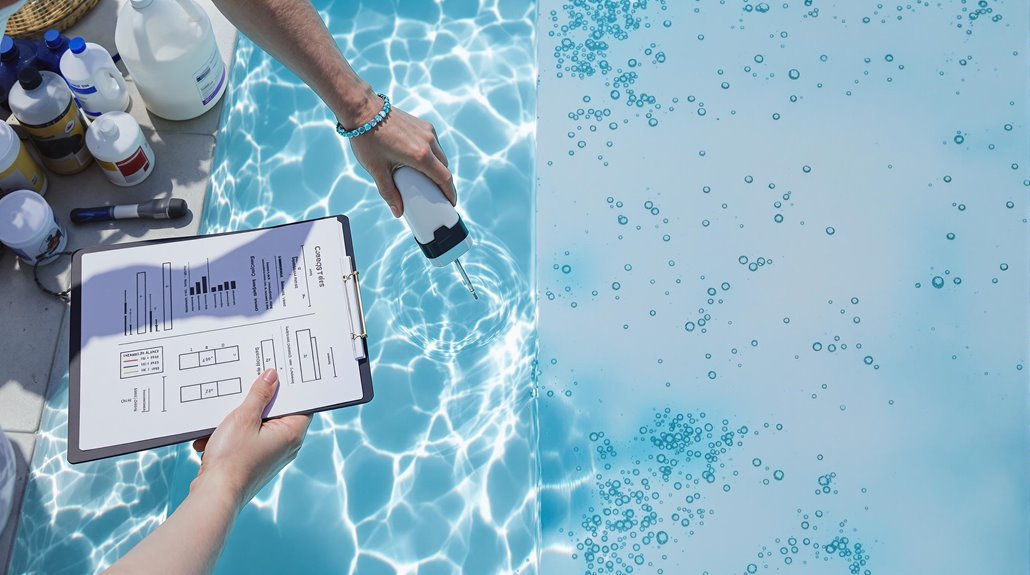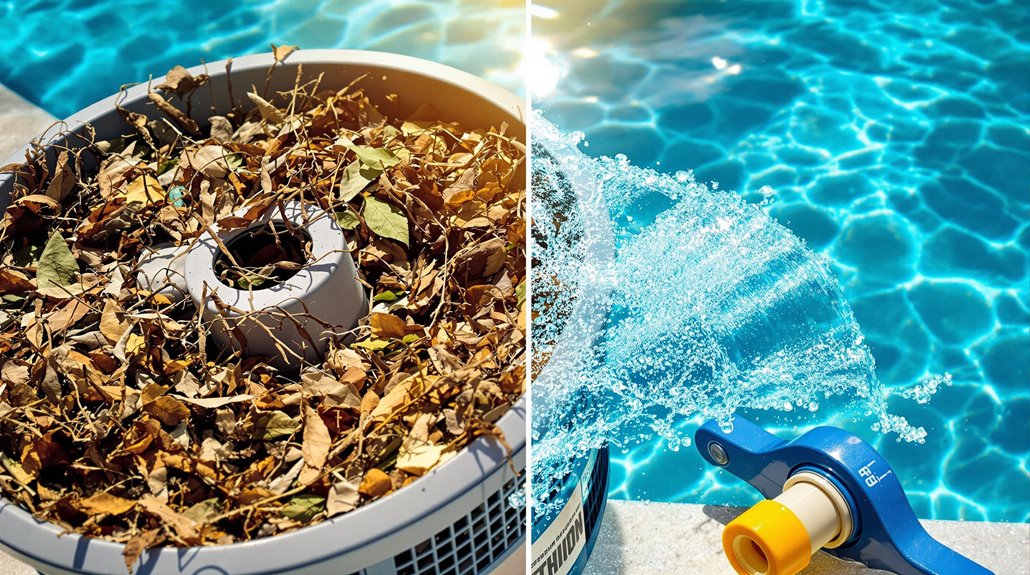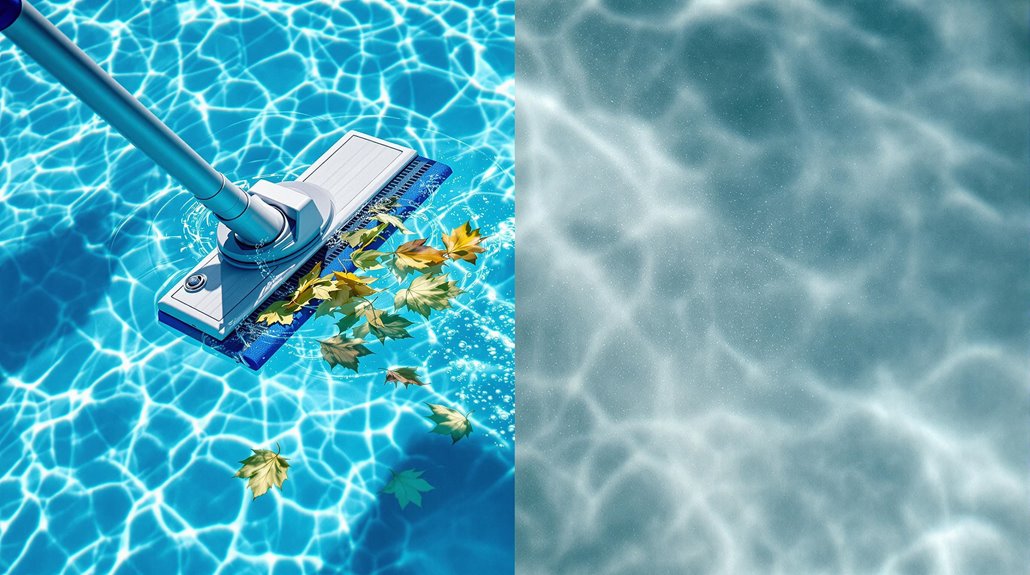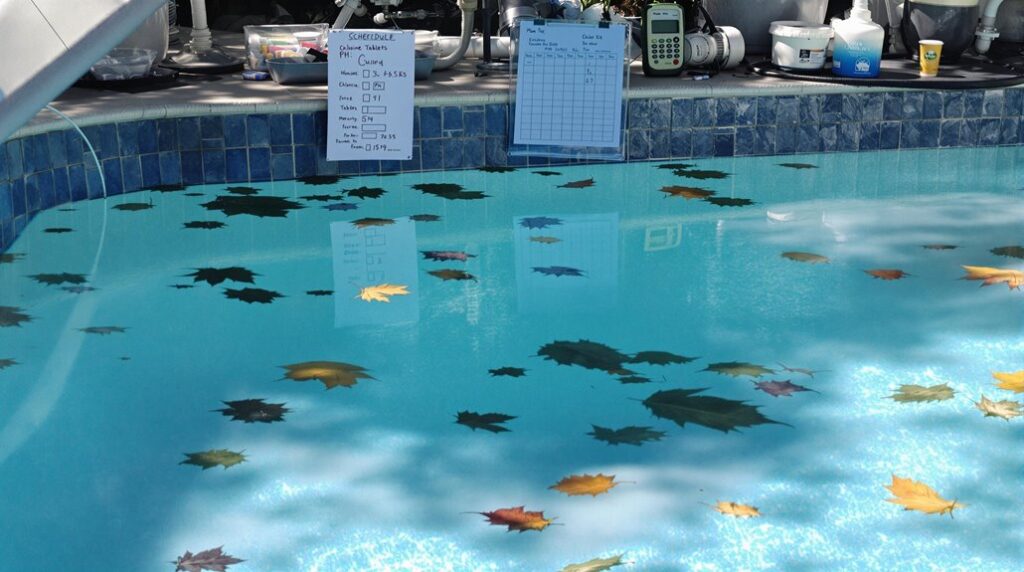Your cloudy pool probably stems from imbalanced water chemistry, poor filtration, or improper chemical application. To clear it up, you’ll need to test water weekly, run your filter 8-12 hours daily, maintain clean filter components, shock during peak times, remove debris promptly, and guarantee proper chemical dosing. Check that your circulation system effectively distributes sanitizer throughout the pool. Understanding these seven key maintenance areas will help transform your cloudy water into crystal-clear swimming conditions.
Test and Balance Your Water Chemistry Weekly

Anyone who owns a pool knows that maintaining proper water chemistry is essential for safe, crystal-clear swimming conditions. You’ll need to test your water weekly using either test strips for quick checks or liquid test kits for higher accuracy. Focus on five key measurements: pH (7.2-7.6), free chlorine (1-3 ppm), total alkalinity (80-120 ppm), calcium hardness (200-400 ppm), and cyanuric acid (30-50 ppm). Regular pool heater maintenance can help prevent chemical imbalances that contribute to cloudy water. Year-round maintenance ensures your pool stays pristine through every season. Using test strip storage in a cool, dry place helps maintain accuracy of your readings.
For the most accurate results, collect water samples from 18 inches below the surface after running your filter for an hour. If you’re using test strips, dip them for 2-3 moments; with liquid kits, follow precise drop counting techniques. When chemical readings fall outside normal ranges, use systematic troubleshooting to identify and correct the underlying issues. Whenever readings are off, address issues systematically – start with pH and total alkalinity before adjusting other levels. Regular monitoring of your pool’s pH balance range between 7.2 and 7.6 is crucial for maintaining crystal clear water.
Run Your Pool Filter for Adequate Hours Daily
While running your pool filter might seem akin to a straightforward task, getting the timing right is essential for maintaining crystal-clear water. The runtime requirements depend on your pump type and environmental conditions, with single-speed pumps needing about one hour per 10°F of air temperature, while variable-speed units require 8-12 hours daily.
Proper pool filter timing is crucial – run single-speed pumps one hour per 10°F, or variable-speed units 8-12 hours daily for clear water.
For ideal filtration and water clarity, follow these key guidelines:
- Run your pump during off-peak hours to maximize energy savings while maintaining proper circulation
- Extend runtime when experiencing heavy swimmer load or during periods of extreme heat
- Split your daily filtration into multiple cycles using timers for more effective debris removal
If persistent cloudiness occurs after 12+ hours of filtration, check your chemical balance and filter pressure, ensuring proper maintenance of all system components.
Keep Your Filter System Clean and Maintained

Running your pool filter consistently won’t matter if the system itself isn’t properly maintained. You’ll need to monitor your pressure gauge regularly, establishing a baseline reading whenever the filter is clean. Whenever the pressure rises 8-10 PSI above normal, it’s time for cleaning.
Different filter types require specific maintenance schedules. For cartridge filters, hose down the pleats weekly and perform a deep clean with TSP solution every six months. Sand and DE filters need backwashing when pressure spikes, while all filter types benefit from monthly housing drains to remove debris. Watch for signs of reduced efficiency, such as weak return jets or poor circulation. Check your filter pressure before assuming chemical imbalances are causing cloudy water, and always verify the gauge returns to baseline after maintenance. Regular filter system maintenance helps maximize equipment longevity and performance while reducing replacement costs.
Shock Your Pool at the Right Time and Amount
Because your pool’s chemistry demands regular maintenance, shocking it correctly is vital for keeping the water crystal clear and safe. You’ll want to shock your pool during peak conditions – at dusk or dawn while UV rays won’t degrade the chlorine, and at the point the pH level sits between 7.2-7.4 for maximum effectiveness. Using copper-based algaecides alongside shocking can provide enhanced protection against stubborn algae growth. If your pump isn’t working properly, low water flow can significantly reduce the effectiveness of pool shock treatments. Regular skimming helps remove debris that can react with shock chemicals and reduce their effectiveness. A thorough spring inspection of your pool equipment ensures everything is working properly before starting your shock treatment routine.
For best results, follow these key shocking guidelines:
- Use 1 pound of shock per 10,000 gallons of water, distributing it evenly around the pool’s perimeter
- Run your pump for at least 6 hours after shocking to guarantee proper filtration
- Wait until free chlorine drops to 3 ppm before swimming again, typically 24 hours
Remember to test your water 12-24 hours after shocking and adjust the chemistry as needed. Shocking after heavy pool use or during algae blooms helps maintain pristine water quality. Weekly pool shocking is recommended during peak swimming season to maintain optimal sanitization levels.
Prevent and Remove Excess Debris

Since maintaining a debris-free pool is essential for both water quality and equipment longevity, you’ll need to establish a consistent cleaning routine. Start by using a skimmer net daily to catch floating debris before it sinks, and vacuum your pool floor weekly to remove settled particles. Don’t forget to empty skimmer and pump baskets daily to prevent clogs.
Make brushing pool surfaces a weekly habit, paying special attention to corners, steps, and the waterline where debris tends to accumulate. You’ll want to invest in efficient cleaning tools such as a PoolSkim bag or robotic cleaner to capture particles as small as 3 microns. To minimize debris entry, trim overhanging trees and install a leaf guard. Remember to backwash your filter daily and maintain proper pump runtime of at least 8 hours each day. Regular attention to pool tile cleaning will prevent calcium buildup and maintain your pool’s pristine appearance.
Choose and Apply Pool Chemicals Correctly
A pristine pool requires more than just physical cleaning – proper chemical balance guarantees safe, sparkling water. Understanding and maintaining the right chemical levels will prevent cloudiness and guarantee your pool stays crystal clear. Your success depends on choosing the right sanitizer system and maintaining proper chemical balance. Consider that saltwater pool systems can be gentler on skin and eyes while still providing effective sanitization.
Beautiful pool water starts with smart chemistry – maintaining proper sanitizer and chemical levels is essential for safe, inviting swimming.
Here’s what you need to monitor:
- Keep sanitizer levels precise: chlorine at 1-3 ppm, bromine at 3-5 ppm, or follow specific requirements for alternative systems
- Maintain pH between 7.4-7.6 and total alkalinity at 100-150 ppm to maximize sanitizer effectiveness
- Use cyanuric acid (30-50 ppm) for outdoor pools to protect chlorine from UV degradation
Test your water weekly and adjust chemicals accordingly. If your total dissolved solids exceed 1,500 ppm, perform a partial drain and refill to restore proper balance.
Optimize Your Pool’s Circulation System
While sparkling water relies on proper chemical balance, your pool’s circulation system serves as its essential lifeline, continuously filtering debris and distributing sanitizing chemicals. To maximize efficiency, run your pump 8-12 hours daily, ensuring complete water turnover. If you’ve got a variable speed pump, operate it at lower speeds for longer periods to save energy while maintaining effectiveness.
Set your suction manifold valves to direct 75% suction to skimmers and 25% to main drains, prioritizing surface debris removal. Angle return jets downward about 2-3 feet beneath the surface to create a circular flow that pushes floor debris toward drains. Don’t forget to clean strainer baskets daily and backwash your filter weekly or when pressure rises 8-10 PSI to maintain ideal flow rates. A sudden increase in pump run time needed to maintain clear water could indicate an underlying leak requiring inspection.
Frequently Asked Questions
How Long Does It Take for a Cloudy Pool to Clear Up?
Cloudy pools clear in 1-3 days with flocculants, 2-3 days with clarifiers, and 3 days for algae treatment.
Can Swimming in Cloudy Pool Water Make You Sick?
Swimming in cloudy pools is unsafe. Cloudy water can contain pathogens like E. coli, Giardia, and Legionella, causing stomach infections and respiratory illness.
Does Rain Always Make a Pool Cloudy?
No. Rain causes cloudiness primarily during heavy downpours or when pool chemicals aren’t balanced for the added water volume.
Why Does My Pool Get Cloudy Even With Perfect Chemistry?
Pool cloudiness occurs from poor filtration, contaminants from swimmers, and worn equipment, even with balanced chemistry. Proper circulation and maintenance are essential.
Should I Drain My Pool if It Won’t Stop Being Cloudy?
Don’t drain pool. First adjust filtration time, clean filters, use clarifiers. Only drain partially if calcium exceeds 400 ppm or TDS is unmanageable.

